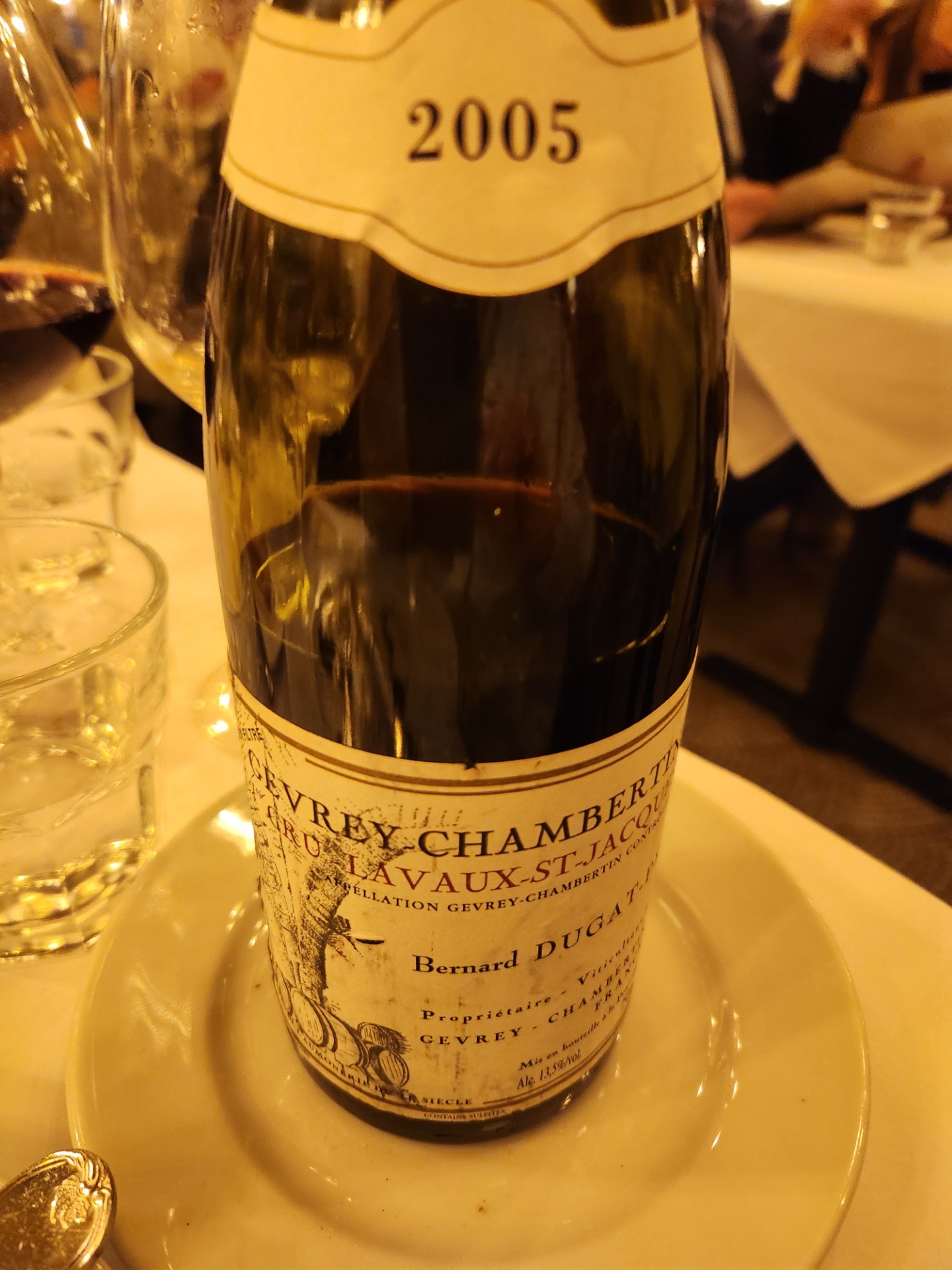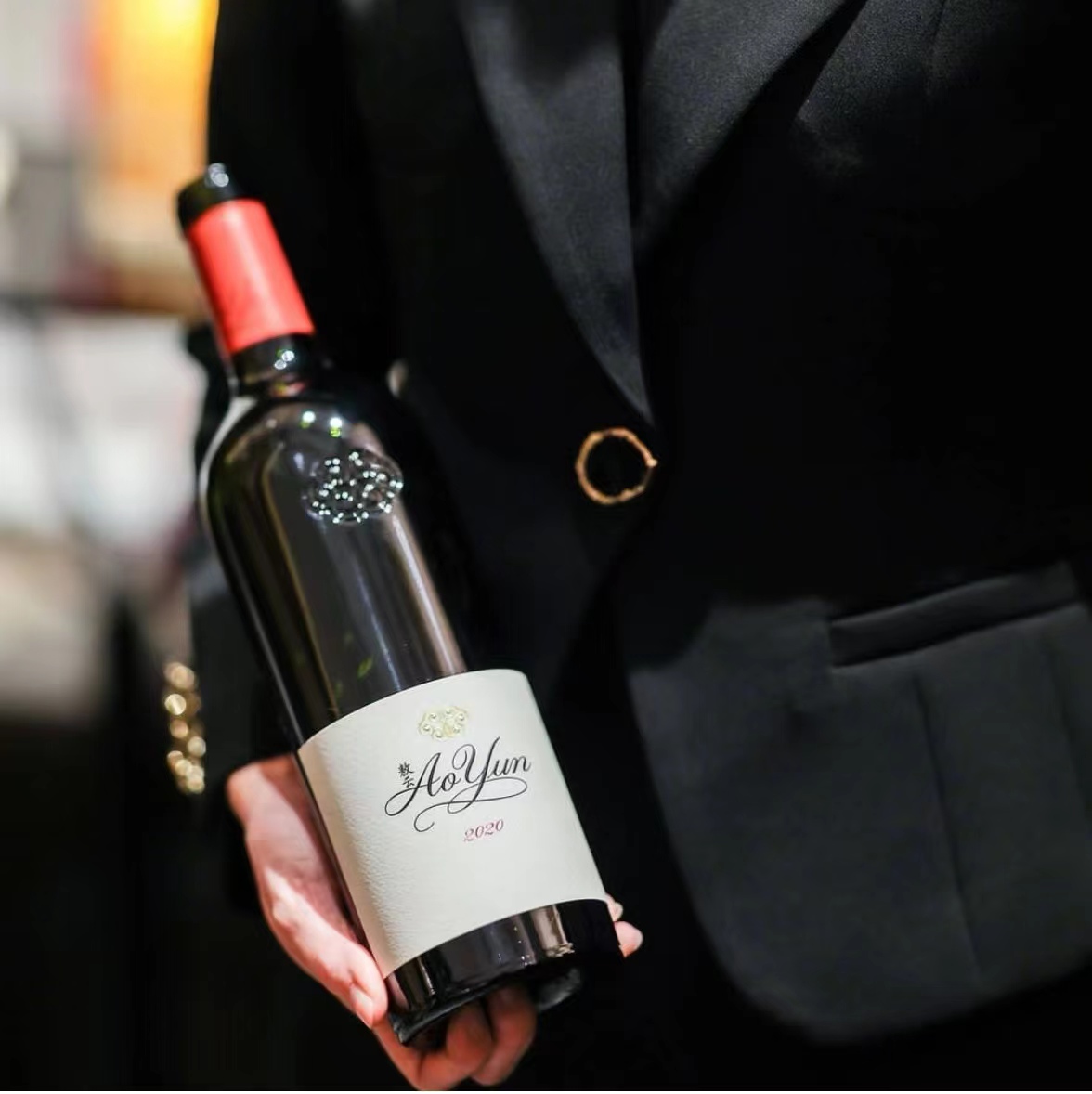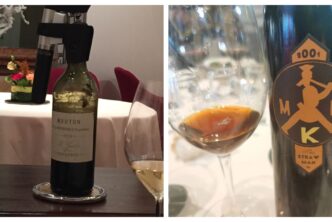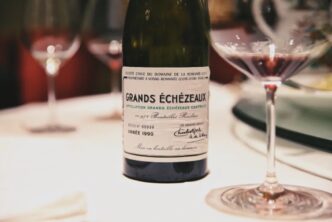Dugat-Py 2005 Gevrey Chambertin Lavaux St. Jacques 95
by Robert Millman

After many years of aging or perhaps I should say nursing my one bottle of Bernard Dugat’s 2005 Gevrey Chambertin Lavaux St. Jacques I found a suitable occasion for drinking the wine: a friend’s birthday. The celebration took place at Daniel Boulud’s restaurant Le Gratin which is a modern homage to the Lyonnaise food in which he was raised as a young man. The centerpiece of the restaurant is the famous gratin de pommes de terre in which thin slices of potato are cooked slowly in a mixture of milk, cream and butter until the potatoes have absorbed all but a small amount of the liquid. If there is a more delicious preparation in the world of cuisine I would not be able to name it. On this evening, it was served with loin of veal in a stock sauce accompanied by buttery English peas. The food called for first rate red wine: In this case a profound Burgundy from the village of Gevrey Chambertin which is home to some the best and most imposing wines made in France. The 2005s are seventeen years in bottle at this point. Enough time? Yes and no. The 2005 vinatge was a very warm one which below average amounts of rain fell. The skins of the Pinot Noir came to the sorting tables with the kind of thick skins which means that there would be a small amount of juice only, with substantial tannins. The critics were unanimous in praise of the young 2005s with the proviso that they might take a long time to shed their tannic protective shield. This has proved to be very much the case.
Dugat-Py is a very small estate of some ten hectares which has managed to obtain vineyard land in Pommard and Vosne-Romanée in the last twenty years. Frankly, it is their ten Gevrey-Chambertins which express the soul of the estate. When I look at the miniscule size of the Dugat-Py holding—only the village Gevrey provides any real volume—I can only wonder at the amount of work it takes every years to produce what are such small amounts of wine. To be sure the domaine has an outstanding reputation and the wines command relatively high prices. There are five Premier Crus and four Grand Crus—a microcosm of the village. The vines are trained for small yields and even smaller berries. The vines are old to very old. The wines are at once deeply pitched, classy and yet tightly wound for long-haul aging. The Lavaux has the most flesh of the Dugat-Py Premier Crus as befits the vineyard. Lavaux is one of those sites which smile on dedicated vignerons. Due to the cool breezes which permeate the site, Lavaut St. Jacques does particularly well in very warm vintages. It is the largest of the 27 Premier Crus which make up nearly 30% of the vineyards in Gevrey Chambertin.
The first fact to note about the 2005 Dugat-Py was the color: virtually pitch black at the core, with no signs of aging on the wine’s edge. Some of this is vintage but a good part due to the small production at the estate. The bouquet had a remarkable sweet tobacco persistence with notes of iron, black berries and leather. The bouquet suggested that the wine had reached a vigorous middle age with plenty of life ahead. The palate confirmed the bouquet. Dense, earthy yet lifted and energetic, the wine’s abundant ripe tannins dominate the finish. (I could not help think that if a top Barolo producer made a Burgundy this is what it might be like.) The wine seemed younger after two hours than when we started tasting it! I suspect that those who are lucky enough to own bottles of this wine and have the patience to wait at least five more years will be rewarded with something quite exceptional. Still, I am thankful to have experienced this majestic wine, even if is still on the rise. Drinking Window 2025-2035+.
Ao Yun 2020 Grand Cru Shangri-La Yunnan China 96

There can be not much of an argument with the statement that Ao Yun is China’s best wine. It is, and that’s it. This LVMH-owned estate in Yunnan, China, produces the flagship wine of the French luxury pole in Asia, a wine that has gone from strength to strength ever since its first vintage, the already outstanding 2013. That 90% Cabernet Sauvignon and 10% Cabernet Franc blend was on a par with many first and second growth -classed Bordeaux wines, though the tannins were then a bit more rustic than the best from France. Something that has been changed with the more recent vintages, in all of which Ao Yun delivers utmost precision and class, while providing beautifully creamy tannins and mouth-watering freshness. Best wine in China? Yes, and it would be strange if it were otherwise, given the incredible work that is being done at the property. Read’em and weep: the grapes are sourced from four different villages located between 2100-2600 meters above sea level, high up in the Himalayas mountain range. The hectares under vine are only 27, but the soil types are at least 35; these twenty-seven hectares are broken down into an unbelievable 314 blocks and further sub-divided into another 727 sub-blocks (yes 727, you read that right), requiring 110 local families to spend about 3500 hours of work by hand to tend to the vines. The wine has changed in other aspects as well. With the 2016 vintage, Petit Verdot and Syrah were added in small percentages, while in 2017 Merlot also found its way into the blend (each of these three varieties constitute less than 10% of the total blend, which remains a mostly Cabernet Sauvignon and Cabernet Franc wine). Another change at the winery has been that since 2018, Ao Yun has started bottling single-villages wines, that are sold at about two -thirds the price of the grand vin, and represent excellent value given how good they are. The villages are Adong (highest up, it gives the freshest, sultriest wines); Sinong (the most powerful villages wine, it needs to open in the glass for a couple of hours, but is then utterly beautiful; Xidang, that gives usually the fruitiest and spiciest wines of the lot; last bit not least, Shuori gives the most balanced wines and in both 2019 and 2020 no villages wine from Shuori was released. The final Ao Yun blend of grapes from the four villages will vary in each village. In 2020, for example, the village grapes composition of the Ao Yun Grand Vin is 10% Xidang, 18% Sinong, 38% Shuori, and 34% Adong. The grape variety blend is: 60% Cabernet Sauvignon, 19% Cabernet Franc, 10% Merlot, 6% Syrah and 5% Petit Verdot. This spent only 12 months in 30% new barrel, 30% old barrel and 40% Stone Ware Jar, then last 8 months in stainless steel tank. Drinking window: 2028-2040.

 English
English

